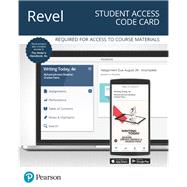For courses in English Composition.
Practical writing skills for composing in the real world
Revel™ Writing Today is an accessible book that fits the way people today read and learn. Its chunked writing style; eye-catching design; and focus on writing genres, strategies, and processes set you up for success in your college courses, your career, and your civic life.
The 4th Edition marks a turning point in this highly successful series. Authors Richard Johnson-Sheehan and Charles Paine have made reflection — or discovering why we think the way we do — one of the central concepts of the revision. As you explore this, you’ll become intellectually stronger, more aware, more versatile, and more resilient.
Revel is Pearson’s newest way of delivering our respected content. Fully digital and highly engaging, Revel replaces the textbook and gives students everything they need for the course. Informed by extensive research on how people read, think, and learn, Revel is an interactive learning environment that enables students to read, practice, and study in one continuous experience — for less than the cost of a traditional textbook.
This product is a part of the Revel Plus One program and includes access to Johnson-Sheehan/Paine, Writing Today and Faigley, The Writer’s Handbook within a single Revel course.
NOTE: Revel is a fully digital delivery of Pearson content. This ISBN is for the standalone Revel access card. In addition to this access card, you will need a course invite link, provided by your instructor, to register for and use Revel.











